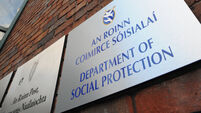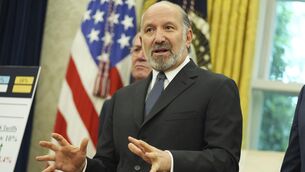Few safe havens for your investment after poor year for pensions

The dominant economic theme is how high will rates have to go to get inflation under control.
Last year was a very poor year for pension performance, especially for the retired, who are most likely in an Approved Retirement Fund (ARF).
Some investment funds fell as much as 15%, and taken with your 4%/5% annual payment, your pot could have declined up to 20% in a single year.
That is a hammer blow. Even those cautious investors who have a low-risk setting only ended up with more bonds in their portfolio, and bonds were the worst-performing asset class, losing up to 30% on some maturities.
Last year, there were very few places to hide.
For those coming close to retirement, say, 10 years to go, it was still a major setback, but they still have time to recover. Low-risk cautious funds still contain too many bonds and as interest rates are still rising, bonds are likely to underperform again this year. It is worth noting that a low-risk setting is rarely the correct choice, as fees and charges eat up any potential returns, even in a good year.
With ultra-low interest rates in the rear-view mirror, annuities are making a comeback. There are two options when you retire:
1. Move to an ARF and continue to invest, drawing an income from the ARF for the rest of your life. Any balance left after you die is owned by your estate.
2. Buy an annuity, give your fund over to a life company who calculate an annual pension that is paid to you until you die. Annuities can have benefits for dependants, but will detract from the value of the pension you receive. Any funds left after the pension payouts are kept by the life company.
Current annuity rates (depending on your circumstances) are roughly 5% per annum. So if you have a pot of €400,000, your annual pension will be €20,000. Annuities are very interest-rate-sensitive, so the higher rates go, the better your income.
Many see the current market volatility as scary and are tempted to lower their risk, but this is a mistake. Yes, the markets are volatile and will remain so, because Central Banks have left the building. No more ultra-low interest rates, no more money-printing (QE). The market is having withdrawal symptoms, experiencing "cold turkey".
We have relied on Central Bank support since the last financial crisis, but that has gone now. In fact, the Central banks are doing the exact opposite, raising rates and withdrawing liquidity from the markets. That is causing nervousness, skittishness, and volatility.
Add to that the fact that some banks (Silicon Valley Bank) have not managed to control their interest-rate risk-exposure and have gone bust. SVB or Credit Suisse are not systemic, so we are not headed for a full banking crisis. They will influence lending where credit will be tighter, which will lead to lower economic activity, however.
The dominant economic theme is how high will rates have to go to get inflationunder control. Central Banks have a thankless task — stop raising rates too early and inflation will spike again, go too high and we may get a serious credit event, ie a bank failure that is systemic.
All this means the investing world has changed. Those thinking of going back to the portfolios that made money up to December 2021 may be in for a surprise.
The US stock market is still overvalued and exposed to higher rates. In tech, maybe the big ones will do OK, but most will struggle. Bonds are still not an investable option in our opinion.
What is needed here is a good proportion of alternative investments in your pension fund. That should include inflationary assets such as commodities, gold and silver, climate plays, including stocks which will benefit from the $10 trillion of investment due in that sector over the coming years. Value stocks, ie stocks that have low debt, pay a dividend and have a meaning to exist.
The concept that the old 60/40 portfolio will get you the returns over the next five years is a stretch. The good news is there will be a yield in bonds eventually. The ECB are currently at 3.5%, however, the banks are still way below that. In time we should get deposit rates of around 3%. Not enough to fight inflation, but enough to improve annuity returns.
The investment outlook for this year continues to be difficult.
We see oil prices rising again and inflation remaining high. That means more rate increases, which are bad for indebted stocks and bonds.
You need assets in your portfolio that perform well in inflationary times. The last inflation cycle lasted a decade, the predictions that this one will end in 18 months are very wide of the mark, in our view.













